
Los Angeles Downtown Walking Tour (Self Guided), Los Angeles
The history of Los Angeles – "a bright and guilty place," as Orson Welles described it – began on September 4, 1781, when a group of 44 Spanish settlers established a hamlet on the territory of present-day Downtown LA which they called “The Town of Our Lady the Queen of the Angels” (El Pueblo de Nuestra Señora la Reina de los Ángeles).
The land became part of Mexico in 1821, following the Mexican War of Independence, and after the Mexican–American War, in 1848, the whole of California was purchased by the United States. This transformation entailed significant changes including the completion of the Santa Fe railroad which linked Los Angeles to Chicago, in 1885, subsequently bringing the flood of migrants ("overlanders") from the Lower Midwest and South of the country. During the 1880s and 90s, LA's population exploded nearly 10-fold, from 11,000 to 100,000.
By 1920, the city turned into a large metropolitan area, with Downtown LA at its center. Following World War II, and particularly throughout the 1960s, the Downtown suffered a bit of a decline.
However, in the early 2000s, the neighborhood picked up again, becoming especially popular with artists due to the low rent, abundance of loft spaces, and numerous vacancies. As of 2009, Downtown LA has been enjoying a new life, notably described as "a neighborhood with an increasingly hip and well-heeled residential population".
Apart from its film industry, which made Los Angeles world-famous – indeed, "We are all citizens of Los Angeles because we have seen so many movies," D.J. Waldie once said – the city has a strong economic base in tourism. You can see droves of tourists regularly go up and down Angels Flight Railway, or climb 70 floors up at the iconic OUE Skyspace to appreciate "the most beautiful city in the world, as long as it's seen at night and from a distance," according to Roman Polanski.
Those keen on music can't pass The Grammy Museum either, with its interactive exhibits. At some point, having toured the multiple landmarks, visitors often stop for a quick snack at the bustling Grand Central Market or grab a cup of coffee at the historic Pantry Cafe (operational non-stop since 1924!!!).
If you’re looking for a healthy dose of unique architecture, great food, fascinating museums, and countless hours of entertainment, you will find all this and more in Downtown LA – rest assured. Just embark on this self-guided walking tour and explore the heart of Los Angeles, “a microcosm of the United States” to your heart's content, learning about its past, present, and future.
The land became part of Mexico in 1821, following the Mexican War of Independence, and after the Mexican–American War, in 1848, the whole of California was purchased by the United States. This transformation entailed significant changes including the completion of the Santa Fe railroad which linked Los Angeles to Chicago, in 1885, subsequently bringing the flood of migrants ("overlanders") from the Lower Midwest and South of the country. During the 1880s and 90s, LA's population exploded nearly 10-fold, from 11,000 to 100,000.
By 1920, the city turned into a large metropolitan area, with Downtown LA at its center. Following World War II, and particularly throughout the 1960s, the Downtown suffered a bit of a decline.
However, in the early 2000s, the neighborhood picked up again, becoming especially popular with artists due to the low rent, abundance of loft spaces, and numerous vacancies. As of 2009, Downtown LA has been enjoying a new life, notably described as "a neighborhood with an increasingly hip and well-heeled residential population".
Apart from its film industry, which made Los Angeles world-famous – indeed, "We are all citizens of Los Angeles because we have seen so many movies," D.J. Waldie once said – the city has a strong economic base in tourism. You can see droves of tourists regularly go up and down Angels Flight Railway, or climb 70 floors up at the iconic OUE Skyspace to appreciate "the most beautiful city in the world, as long as it's seen at night and from a distance," according to Roman Polanski.
Those keen on music can't pass The Grammy Museum either, with its interactive exhibits. At some point, having toured the multiple landmarks, visitors often stop for a quick snack at the bustling Grand Central Market or grab a cup of coffee at the historic Pantry Cafe (operational non-stop since 1924!!!).
If you’re looking for a healthy dose of unique architecture, great food, fascinating museums, and countless hours of entertainment, you will find all this and more in Downtown LA – rest assured. Just embark on this self-guided walking tour and explore the heart of Los Angeles, “a microcosm of the United States” to your heart's content, learning about its past, present, and future.
How it works: Download the app "GPSmyCity: Walks in 1K+ Cities" from Apple App Store or Google Play Store to your mobile phone or tablet. The app turns your mobile device into a personal tour guide and its built-in GPS navigation functions guide you from one tour stop to next. The app works offline, so no data plan is needed when traveling abroad.
Los Angeles Downtown Walking Tour Map
Guide Name: Los Angeles Downtown Walking Tour
Guide Location: USA » Los Angeles (See other walking tours in Los Angeles)
Guide Type: Self-guided Walking Tour (Sightseeing)
# of Attractions: 9
Tour Duration: 2 Hour(s)
Travel Distance: 3.5 Km or 2.2 Miles
Author: ashley
Sight(s) Featured in This Guide:
Guide Location: USA » Los Angeles (See other walking tours in Los Angeles)
Guide Type: Self-guided Walking Tour (Sightseeing)
# of Attractions: 9
Tour Duration: 2 Hour(s)
Travel Distance: 3.5 Km or 2.2 Miles
Author: ashley
Sight(s) Featured in This Guide:
- Grand Park
- Walt Disney Concert Hall
- The Broad
- Museum of Contemporary Art (MOCA)
- Grand Central Market / Homer Laughlin Building
- Angels Flight Railway
- The Bloc
- Original Pantry Cafe
- GRAMMY Museum
1) Grand Park
With only 12 acres (4.9 hectares) of land to it, LA's Grand Park pales in comparison to other major urban parks in the U.S., in terms of size. However, this lack of landmass is overcompensated by beautiful surroundings in which dozens of buildings cascade downhill to create a majestic, almost Roman sense of design and continuity in one of the country's most architecturally magnificent community areas.
Indeed, the power, beauty, history, and future of Los Angeles are masterly displayed here in full splendor in the sleek lines of the Los Angeles Department of Water and Power building, the Music Center Plaza, and the Modern American-style City Hall overlooking the park.
Inspired by the City Beautiful movement, landscape architect Charles Mulford Robinson proposed to create this park area in 1907. However, it took half a century to cluster the LA County government buildings in one place before the park project finally materialized, in 1957. As for the Civic Center – the administrative core of the City and County of Los Angeles complete with plazas, fountains, and a Court of Flags, – this undertaking was accomplished in 1966.
Gated off and safe to roam, the pedestrian-friendly park features tree-shaded sidewalks, a tropical greenhouse, a radiant colorful water fountain, performance lawns, and courtyards, as well as restrooms and snack kiosks to encourage visitors to walk and explore. In addition to providing scenic photo opportunities, the place is famous for hosting seasonal social events, such as summer dancing and movie screenings, fitness boot camps, plant sales, the Day of the Dead (Día de Muertos) festival, and, of course, New Year's Eve countdown. And the best part is that most, if not all, of these events are free!
Indeed, the power, beauty, history, and future of Los Angeles are masterly displayed here in full splendor in the sleek lines of the Los Angeles Department of Water and Power building, the Music Center Plaza, and the Modern American-style City Hall overlooking the park.
Inspired by the City Beautiful movement, landscape architect Charles Mulford Robinson proposed to create this park area in 1907. However, it took half a century to cluster the LA County government buildings in one place before the park project finally materialized, in 1957. As for the Civic Center – the administrative core of the City and County of Los Angeles complete with plazas, fountains, and a Court of Flags, – this undertaking was accomplished in 1966.
Gated off and safe to roam, the pedestrian-friendly park features tree-shaded sidewalks, a tropical greenhouse, a radiant colorful water fountain, performance lawns, and courtyards, as well as restrooms and snack kiosks to encourage visitors to walk and explore. In addition to providing scenic photo opportunities, the place is famous for hosting seasonal social events, such as summer dancing and movie screenings, fitness boot camps, plant sales, the Day of the Dead (Día de Muertos) festival, and, of course, New Year's Eve countdown. And the best part is that most, if not all, of these events are free!
2) Walt Disney Concert Hall (must see)
No classical music lover should pass up a concert at the Walt Disney Concert Hall, which is home to the Los Angeles Philharmonic Orchestra and the Los Angeles Master Chorale. Considered one of the best concert halls in the world, it was built by Frank Gehry and opened in 2003, following an initial $50-million donation by Lillian Disney, Walt Disney's widow. The building is on six levels and its elegant stainless steel curves are formed to resemble a bowl of white roses, as a tribute to its generous benefactress.
Architecture buffs and concert hall buffs, in particular, may find similar vibes between this and the Berlin Philharmonic Hall (Berliner Philharmonie) in both the exterior lines and internal layout, even though the two venues were built 40 years apart and on two different continents. The magnificent acoustics, designed by Yasuhisa Toyota, allow for every orchestral sound – including adagios – to be point sharp, even at the furthest point from the stage. In turn, seating is well designed and extremely comfortable, providing unobstructed views of the performance throughout the entire hall, no matter where you sit.
The LA Philharmonic concerts (indeed, the best in town) would easily set you back $100-300 a ticket, but a little research and planning in advance may get you in for ten times less! One way is to look for the $20 tickets that they offer every now and then – only a few concerts per season; but if you can find them, it's a great deal. Another way to enjoy a decent concert is to look for California Philharmonic events. This smaller orchestra also performs here regularly and their tickets are quite affordable.
Tip:
The free self-guided tour is well worth taking if you have time to spare during the day.
Just leave an ID for the audio guide and you can spend around an hour taking the tours and enjoying the lovely little 3rd-floor park with its huge marble lotus flower.
Architecture buffs and concert hall buffs, in particular, may find similar vibes between this and the Berlin Philharmonic Hall (Berliner Philharmonie) in both the exterior lines and internal layout, even though the two venues were built 40 years apart and on two different continents. The magnificent acoustics, designed by Yasuhisa Toyota, allow for every orchestral sound – including adagios – to be point sharp, even at the furthest point from the stage. In turn, seating is well designed and extremely comfortable, providing unobstructed views of the performance throughout the entire hall, no matter where you sit.
The LA Philharmonic concerts (indeed, the best in town) would easily set you back $100-300 a ticket, but a little research and planning in advance may get you in for ten times less! One way is to look for the $20 tickets that they offer every now and then – only a few concerts per season; but if you can find them, it's a great deal. Another way to enjoy a decent concert is to look for California Philharmonic events. This smaller orchestra also performs here regularly and their tickets are quite affordable.
Tip:
The free self-guided tour is well worth taking if you have time to spare during the day.
Just leave an ID for the audio guide and you can spend around an hour taking the tours and enjoying the lovely little 3rd-floor park with its huge marble lotus flower.
3) The Broad (must see)
LA's newest contemporary art museum, The Broad, was founded by philanthropists Eli and Edythe Broad and opened to the public in September 2015. Housed in a striking, honeycomb-like building designed by the architectural firm Diller Scofidio + Renfro, the museum itself is very much an attraction in its own right. Its distinctive metallic exterior is made up of 2,500 fiberglass-reinforced concrete panels, which allow natural light to filter into the galleries while also providing shade and insulation.
"The Broad" is an apt name for this museum as it presents a wide array of modern art pieces. The collection consists of over 2,000 works of art, spanning many decades, from the postwar to contemporary periods, and various disciplines, with something to see for everyone – of almost any age. The famous standard names here include the likes of Andy Warhol, Jeff Koons, Ed Ruscha, Roy Lichtenstein, and Cindy Sherman, but do check out the multi-media advance offerings and the special exhibits that change on a constant basis. Look out, also, for some of the coolest elevator and escalator rides in the Downtown area.
Inside, the museum exhibition space is organized on two floors, with works arranged thematically rather than chronologically. Visitors can expect to see a wide range of art, from massive sculptures and installations to paintings, photographs, and video works. The museum also has a robust program of temporary exhibitions, which showcase works by emerging and established artists from around the world.
One of the most popular pieces in the museum's permanent collection is Yayoi Kusama's Infinity Mirrored Room - The Souls of Millions of Light Years Away, which is a darkened room filled with reflective orbs that seem to go on forever. To see it, it is recommended that you arrive early – especially on peak-time summer weekends and holidays – and walk quickly to the right side upon entering to put your name on the wait list at the kiosk. Although the time inside the room is limited to a maximum of 45 seconds, you will be left with the quite exquisite feeling of being alone with millions of stars.
Although some special exhibitions may require a fee, the major – and perhaps unique to Downtown – aspect of the Broad is its free general admissions policy for the permanent collection. This has resulted in a far younger, and far more racially/culturally diverse audience than any other art museum in Los Angeles!
The Broad is definitely worth a visit for an hour or two – just make sure to pre-book tickets online and avoid waiting in the standby ticket line!
"The Broad" is an apt name for this museum as it presents a wide array of modern art pieces. The collection consists of over 2,000 works of art, spanning many decades, from the postwar to contemporary periods, and various disciplines, with something to see for everyone – of almost any age. The famous standard names here include the likes of Andy Warhol, Jeff Koons, Ed Ruscha, Roy Lichtenstein, and Cindy Sherman, but do check out the multi-media advance offerings and the special exhibits that change on a constant basis. Look out, also, for some of the coolest elevator and escalator rides in the Downtown area.
Inside, the museum exhibition space is organized on two floors, with works arranged thematically rather than chronologically. Visitors can expect to see a wide range of art, from massive sculptures and installations to paintings, photographs, and video works. The museum also has a robust program of temporary exhibitions, which showcase works by emerging and established artists from around the world.
One of the most popular pieces in the museum's permanent collection is Yayoi Kusama's Infinity Mirrored Room - The Souls of Millions of Light Years Away, which is a darkened room filled with reflective orbs that seem to go on forever. To see it, it is recommended that you arrive early – especially on peak-time summer weekends and holidays – and walk quickly to the right side upon entering to put your name on the wait list at the kiosk. Although the time inside the room is limited to a maximum of 45 seconds, you will be left with the quite exquisite feeling of being alone with millions of stars.
Although some special exhibitions may require a fee, the major – and perhaps unique to Downtown – aspect of the Broad is its free general admissions policy for the permanent collection. This has resulted in a far younger, and far more racially/culturally diverse audience than any other art museum in Los Angeles!
The Broad is definitely worth a visit for an hour or two – just make sure to pre-book tickets online and avoid waiting in the standby ticket line!
4) Museum of Contemporary Art (MOCA)
Located conveniently across the street from The Broad is the Museum of Contemporary Art (MOCA). In fact, this is one of MOCA's two main locations. It houses the museum's permanent collection and is somewhat smaller than its sister venue, the Geffen Contemporary at MOCA, which is located in Little Tokyo and used for temporary exhibitions, events, and performances.
The museum was founded in 1979 by a group of artists and collectors who wanted to create a space dedicated to showcasing the work of living artists. Its permanent collection comprises over 6,000 pieces, including paintings, sculptures, photographs, and installations. The featured artists include such names as Jackson Pollock, Mark Rothko, Andy Warhol, and Jean-Michel Basquiat, among many others.
Alongside seasoned classics of contemporary art, there is plenty of new inspiring works to peruse by emerging and mid-career artists from Southern California and around the world. Visiting here, you may notice that the MOCA is focused not only on the art itself but also on the history of artists, thus enabling viewers to get some background knowledge, too, which is a big plus.
Some of the things to be seen here will invoke strange feelings that you've never got from seeing art before, and the exhibits' variation certainly adds to the quality of the experience – from Robert Frank's much-touted photo series of "The Americans" to "Pattern and Decoration in American Art 1972–85" with fabulous quilts and more. Other highlights include an entire room of Rothko's compositions and a wonderful interactive art installation that has you walk through rooms of different colors.
Art connoisseurs will appreciate the theme of self-reflexivity ("what and who gets to consider what is art?"), especially from the approach of people of color and women artists. If you luck out, you may even join a very knowledgeable docent's tour that takes you through the permanent collection for about an hour. Since the place isn't so big, getting tired here is hardly possible.
Tip:
Don't miss the very creative gift shop (on the upper ground level) for a great array of local and international magazines, unique art books, and other funky finds!
The museum was founded in 1979 by a group of artists and collectors who wanted to create a space dedicated to showcasing the work of living artists. Its permanent collection comprises over 6,000 pieces, including paintings, sculptures, photographs, and installations. The featured artists include such names as Jackson Pollock, Mark Rothko, Andy Warhol, and Jean-Michel Basquiat, among many others.
Alongside seasoned classics of contemporary art, there is plenty of new inspiring works to peruse by emerging and mid-career artists from Southern California and around the world. Visiting here, you may notice that the MOCA is focused not only on the art itself but also on the history of artists, thus enabling viewers to get some background knowledge, too, which is a big plus.
Some of the things to be seen here will invoke strange feelings that you've never got from seeing art before, and the exhibits' variation certainly adds to the quality of the experience – from Robert Frank's much-touted photo series of "The Americans" to "Pattern and Decoration in American Art 1972–85" with fabulous quilts and more. Other highlights include an entire room of Rothko's compositions and a wonderful interactive art installation that has you walk through rooms of different colors.
Art connoisseurs will appreciate the theme of self-reflexivity ("what and who gets to consider what is art?"), especially from the approach of people of color and women artists. If you luck out, you may even join a very knowledgeable docent's tour that takes you through the permanent collection for about an hour. Since the place isn't so big, getting tired here is hardly possible.
Tip:
Don't miss the very creative gift shop (on the upper ground level) for a great array of local and international magazines, unique art books, and other funky finds!
5) Grand Central Market / Homer Laughlin Building (must see)
The Grand Central Market (or GCM as the regulars call it) is a rare place in Downtown LA (DTLA) which serves both as a watering hole for locals and an authentic piece of LA's architectural history for tourists. Opened in 1917, it has been continuously in operation ever since!
GCM's stated mission is lofty: "to celebrate the cuisines and cultures of Los Angeles … to preserve the legacy of a historic downtown landmark … to gather the city's many communities around a shared table" – and it does a very decent job of all that, across 30,000 square feet of space that encompasses a food emporium and a retail marketplace.
The landmark building that houses the market was commissioned by retired Ohio entrepreneur Homer Laughlin and was the city's first fireproofed, steel-reinforced structure when finished in 1898. Originally built in the Beaux Arts style, it underwent subsequent modifications that drastically changed its appearance, including the addition of a tile façade in the 1960s which hid the second-story windows. Along with the adjacent Million Dollar Theater Building, it underwent a major renovation in the 1990s in the course of which residential units were added, creating DTLA's first true mixed-use developments in decades.
GCM's original vendors were Jewish delis, fishmongers, greengrocers, and butchers, with additional stalls for coffee, cheese, baked products, dry goods, eggs, and so forth. As DTLA continued to evolve, the market kept pace, now offering a wide range of cuisines – Mexican, Thai, Peruvian, Japanese, Chinese, Italian, and Mediterranean – as well as desserts and beverages, including ice cream, coffee, pressed juices, beer, wine, and a lot more.
Among the well-known names presented at GCM, you can find McConnell's Fine Ice Cream, Belcampo, Roast-To-Go, Eggslut, Sarita's Pupusaria, Horse Thief BBQ, and Wexler's Deli.
GCM's stated mission is lofty: "to celebrate the cuisines and cultures of Los Angeles … to preserve the legacy of a historic downtown landmark … to gather the city's many communities around a shared table" – and it does a very decent job of all that, across 30,000 square feet of space that encompasses a food emporium and a retail marketplace.
The landmark building that houses the market was commissioned by retired Ohio entrepreneur Homer Laughlin and was the city's first fireproofed, steel-reinforced structure when finished in 1898. Originally built in the Beaux Arts style, it underwent subsequent modifications that drastically changed its appearance, including the addition of a tile façade in the 1960s which hid the second-story windows. Along with the adjacent Million Dollar Theater Building, it underwent a major renovation in the 1990s in the course of which residential units were added, creating DTLA's first true mixed-use developments in decades.
GCM's original vendors were Jewish delis, fishmongers, greengrocers, and butchers, with additional stalls for coffee, cheese, baked products, dry goods, eggs, and so forth. As DTLA continued to evolve, the market kept pace, now offering a wide range of cuisines – Mexican, Thai, Peruvian, Japanese, Chinese, Italian, and Mediterranean – as well as desserts and beverages, including ice cream, coffee, pressed juices, beer, wine, and a lot more.
Among the well-known names presented at GCM, you can find McConnell's Fine Ice Cream, Belcampo, Roast-To-Go, Eggslut, Sarita's Pupusaria, Horse Thief BBQ, and Wexler's Deli.
6) Angels Flight Railway
Just a short distance from the famous Grand Central Market is one of LA's most enduring (and beloved) landmarks, the Angels Flight Railway. This whimsically-named funicular bills itself as "the world's shortest railway". Indeed, it can take you up and down a steep incline between Hill Street and Olive Street, nice and easy, in just a minute or so, which is still enough to put a silly smile on your face, being much fun, albeit, admittedly, of a shorter duration.
The narrow gauge cable railway has only two carriages, endearingly named Sinai and Olivet – roughly from the same era as San Francisco's cable cars – which travel on an almost continuous loop.
The railway first opened on New Year's Eve in 1901 and quickly became a popular mode of transportation. It was originally designed to serve the Bunker Hill district. With its stately Victorian mansions, Bunker Hill was one of LA's very upmarket neighborhoods, and the area's elite residents apparently rode down on Angels Flight to shop for their groceries in Grand Central Market's open-air arcade.
In those days, the well-heeled Bunker Hill residents paid only a penny a ride. Today, the ride costs $1 each way – payable upon alighting at the terminus, which is still a true bargain for a nice piece of history.
In 1912, the"Angels Flight" name (which was originally displayed at the Hill Street entrance archway) became official, and by the 1950s the railway had carried over 100 million passengers already! The count of them to date has been lost...
The railway was closed and dismantled in 1969 due to large-scale development in the area, but was later restored and reopened in 1996. However, tragedy struck in 2001 when a derailment occurred, causing one of the cars to plummet down the track and kill a passenger. After an investigation, the railway was shut down again and remained closed for several years.
In 2010, the historic railway was once again restored and reopened, and today remains in operation.
The narrow gauge cable railway has only two carriages, endearingly named Sinai and Olivet – roughly from the same era as San Francisco's cable cars – which travel on an almost continuous loop.
The railway first opened on New Year's Eve in 1901 and quickly became a popular mode of transportation. It was originally designed to serve the Bunker Hill district. With its stately Victorian mansions, Bunker Hill was one of LA's very upmarket neighborhoods, and the area's elite residents apparently rode down on Angels Flight to shop for their groceries in Grand Central Market's open-air arcade.
In those days, the well-heeled Bunker Hill residents paid only a penny a ride. Today, the ride costs $1 each way – payable upon alighting at the terminus, which is still a true bargain for a nice piece of history.
In 1912, the"Angels Flight" name (which was originally displayed at the Hill Street entrance archway) became official, and by the 1950s the railway had carried over 100 million passengers already! The count of them to date has been lost...
The railway was closed and dismantled in 1969 due to large-scale development in the area, but was later restored and reopened in 1996. However, tragedy struck in 2001 when a derailment occurred, causing one of the cars to plummet down the track and kill a passenger. After an investigation, the railway was shut down again and remained closed for several years.
In 2010, the historic railway was once again restored and reopened, and today remains in operation.
7) The Bloc
The Bloc (stylized as THE BLOC) is a mixed-use development, situated on the site of the former Macy's Plaza and Broadway Plaza in the heart of Downtown LA. This large, modern complex incorporates office spaces, retail stores, and a thoughtfully curated selection of good restaurants and entertainment venues.
The Bloc was originally built in the 1970s as an open-air mall called the "Mall of Downtown Los Angeles," but it was later enclosed and renamed "The Broadway Plaza" after being acquired by The Broadway department store chain. The Broadway Plaza was a popular shopping destination for many years but fell into decline in the 1990s due to the increased competition from other malls and the overall economic downturn in the area. The mall remained largely vacant by the early 2000s.
In 2013, The Ratkovich Company, a real estate development firm, purchased the venue and began an extensive renovation and redevelopment project. The goal was to transform the struggling mall into a modern, urban destination that would appeal to both locals and tourists.
The Bloc officially reopened in 2015 after a $160-million renovation project that included a complete redesign of the interior, the addition of new retail and dining options, and the construction of a state-of-the-art office tower (designed to accommodate a variety of businesses, from small startups to large corporations), fitness center, and a luxury movie theater. Today, The Bloc features more than 400,000 square feet of retail space, including flagship stores for major brands like Macy's and Nordstrom, as well as a variety of restaurants and entertainment venues.
One of its standout features is an open-air plaza that hosts a variety of community events throughout the year, including live music performances, outdoor movie screenings, and art installations. The plaza is surrounded by several restaurants and bars, making it a popular gathering spot.
Owners have been working on making The Bloc more social-media-friendly, so you're encouraged to stop by and bring your selfie-loving cameras or check the website for concerts/movie screenings of interest. The outside seating area is particularly nice and photo-worthy, similar to New York's Meatpacking District, with a Cali touch.
The Bloc was originally built in the 1970s as an open-air mall called the "Mall of Downtown Los Angeles," but it was later enclosed and renamed "The Broadway Plaza" after being acquired by The Broadway department store chain. The Broadway Plaza was a popular shopping destination for many years but fell into decline in the 1990s due to the increased competition from other malls and the overall economic downturn in the area. The mall remained largely vacant by the early 2000s.
In 2013, The Ratkovich Company, a real estate development firm, purchased the venue and began an extensive renovation and redevelopment project. The goal was to transform the struggling mall into a modern, urban destination that would appeal to both locals and tourists.
The Bloc officially reopened in 2015 after a $160-million renovation project that included a complete redesign of the interior, the addition of new retail and dining options, and the construction of a state-of-the-art office tower (designed to accommodate a variety of businesses, from small startups to large corporations), fitness center, and a luxury movie theater. Today, The Bloc features more than 400,000 square feet of retail space, including flagship stores for major brands like Macy's and Nordstrom, as well as a variety of restaurants and entertainment venues.
One of its standout features is an open-air plaza that hosts a variety of community events throughout the year, including live music performances, outdoor movie screenings, and art installations. The plaza is surrounded by several restaurants and bars, making it a popular gathering spot.
Owners have been working on making The Bloc more social-media-friendly, so you're encouraged to stop by and bring your selfie-loving cameras or check the website for concerts/movie screenings of interest. The outside seating area is particularly nice and photo-worthy, similar to New York's Meatpacking District, with a Cali touch.
8) Original Pantry Cafe
The Original Pantry Cafe (or just The Pantry, as the locals call it) is a historic restaurant in Downtown LA that claims to never have been closed or without a customer since its opening in 1924. This claim is also attributed to the fact that the founder, Dewey Logan, never refused a customer even if they were short on money.
When it changed locations, in 1950, to make room for a freeway off-ramp, the place served lunch at the original location and then served dinner at the new location the same day. Still, this iconic LA institution did close once – on the day John F. Kennedy was assassinated. Otherwise, it operates seven days a week, making it a favorite spot for locals and tourists alike.
Those walking in will be astonished by the restaurant's old feel – from the 1900s paintings to the four different layers of flooring. Indeed, the Pantry has a long and eventful history. During the 1960s and 1970s, the restaurant was a popular hangout for celebrities and politicians, including Richard Nixon and Tom Bradley. Bill Clinton famously stopped by for a late-night meal here in 1992, during his presidential campaign.
Currently owned by former Los Angeles mayor Richard Riordan, the eatery is popular for its no-frills and a classic American food menu that has remained largely unchanged over the years. Their breakfast (available all day) is so big that there is no need for lunch; it features all the usual favorites, such as wonderful sourdough bread, eggs, omelets swimming in cheese, French toast and bacon, sausage, or a ham steak that doesn't quite fit on the plate. And don't forget the hash browns grilled to greasy perfection either.
Despite its popularity, the restaurant has never accepted credit cards and has no air conditioning, keeping its original old-school charm. With its hearty portions, classic diner atmosphere, and around-the-clock service you won't leave hungry, that's for sure. And with all the cool surroundings, everything tastes better here. Comforting comfort food in a timeless and comfortable spot!
When it changed locations, in 1950, to make room for a freeway off-ramp, the place served lunch at the original location and then served dinner at the new location the same day. Still, this iconic LA institution did close once – on the day John F. Kennedy was assassinated. Otherwise, it operates seven days a week, making it a favorite spot for locals and tourists alike.
Those walking in will be astonished by the restaurant's old feel – from the 1900s paintings to the four different layers of flooring. Indeed, the Pantry has a long and eventful history. During the 1960s and 1970s, the restaurant was a popular hangout for celebrities and politicians, including Richard Nixon and Tom Bradley. Bill Clinton famously stopped by for a late-night meal here in 1992, during his presidential campaign.
Currently owned by former Los Angeles mayor Richard Riordan, the eatery is popular for its no-frills and a classic American food menu that has remained largely unchanged over the years. Their breakfast (available all day) is so big that there is no need for lunch; it features all the usual favorites, such as wonderful sourdough bread, eggs, omelets swimming in cheese, French toast and bacon, sausage, or a ham steak that doesn't quite fit on the plate. And don't forget the hash browns grilled to greasy perfection either.
Despite its popularity, the restaurant has never accepted credit cards and has no air conditioning, keeping its original old-school charm. With its hearty portions, classic diner atmosphere, and around-the-clock service you won't leave hungry, that's for sure. And with all the cool surroundings, everything tastes better here. Comforting comfort food in a timeless and comfortable spot!
9) GRAMMY Museum
The GRAMMY Museum is dedicated to the history and winners of the Grammy Awards, which are presented by the Recording Academy to honor excellence in the music industry. The museum opened in December 2008 to mark the Grammy Awards' 50th anniversary.
It features a wide range of interactive exhibits and multimedia displays covering various genres of music, as well as the history of recording technology and the impact of music on society. Spread across four floors, the museum's collection includes touch screens, videos, recording booths, plus a rich collection of historical music artifacts. Among them are costumes, instruments, and other memorabilia from legendary musicians and performers, along with hand-written lyrics, records, and audio/video recordings.
Here you will find Elvis Presley's gold lame suit, Michael Jackson's fedora, and a guitar used by Jimi Hendrix. The museum also has outfits worn by Grammy-Award-winning musicians such as Kanye West, Jennifer Lopez, and Rihanna.
The Crossroads exhibit, on the 4th floor, features touch screens to view photos and listen to the music of all genres. Another interactive exhibit allows the user to go inside six different sound-proof recording booths as famous performers and producers teach about the different stages of producing commercial soundtracks. Visitors can record their own singing and rapping track, and remix it to produce a cover of various pop songs.
The museum regularly updates and displays special exhibits dedicated to iconic names of the music industry. Among these are The Beatles, Elvis, Whitney Houston, Michael Jackson, Barbara Streisand, and other great performers.
In addition to its permanent collection, the GRAMMY Museum also hosts a variety of temporary exhibits and special events throughout the year, making it a popular destination for music lovers of all ages.
It features a wide range of interactive exhibits and multimedia displays covering various genres of music, as well as the history of recording technology and the impact of music on society. Spread across four floors, the museum's collection includes touch screens, videos, recording booths, plus a rich collection of historical music artifacts. Among them are costumes, instruments, and other memorabilia from legendary musicians and performers, along with hand-written lyrics, records, and audio/video recordings.
Here you will find Elvis Presley's gold lame suit, Michael Jackson's fedora, and a guitar used by Jimi Hendrix. The museum also has outfits worn by Grammy-Award-winning musicians such as Kanye West, Jennifer Lopez, and Rihanna.
The Crossroads exhibit, on the 4th floor, features touch screens to view photos and listen to the music of all genres. Another interactive exhibit allows the user to go inside six different sound-proof recording booths as famous performers and producers teach about the different stages of producing commercial soundtracks. Visitors can record their own singing and rapping track, and remix it to produce a cover of various pop songs.
The museum regularly updates and displays special exhibits dedicated to iconic names of the music industry. Among these are The Beatles, Elvis, Whitney Houston, Michael Jackson, Barbara Streisand, and other great performers.
In addition to its permanent collection, the GRAMMY Museum also hosts a variety of temporary exhibits and special events throughout the year, making it a popular destination for music lovers of all ages.
Walking Tours in Los Angeles, California
Create Your Own Walk in Los Angeles
Creating your own self-guided walk in Los Angeles is easy and fun. Choose the city attractions that you want to see and a walk route map will be created just for you. You can even set your hotel as the start point of the walk.
Downtown Architecture Walking Tour
For different people, Los Angeles means different things. One such is undoubtedly architecture. Being one of the centers of the Art Deco movement, LA features a great number of amazing historic houses and buildings attributed to this and other, older and more modern styles.
One prominent landmark is the Cathedral of Our Lady of the Angels, a contemporary construction masterpiece with its... view more
Tour Duration: 2 Hour(s)
Travel Distance: 2.6 Km or 1.6 Miles
One prominent landmark is the Cathedral of Our Lady of the Angels, a contemporary construction masterpiece with its... view more
Tour Duration: 2 Hour(s)
Travel Distance: 2.6 Km or 1.6 Miles
Movie Studios Tour
The film studios of Los Angeles, collectively known as the “dream factory”, are indeed factories. Here, countless iconic films and television shows have been produced over the years, creating stars and attracting great movie-makers from around the globe. Let's take a brief look at some of these vital hubs in the entertainment industry.
Raleigh Studios is one of the oldest continuously... view more
Tour Duration: 2 Hour(s)
Travel Distance: 3.9 Km or 2.4 Miles
Raleigh Studios is one of the oldest continuously... view more
Tour Duration: 2 Hour(s)
Travel Distance: 3.9 Km or 2.4 Miles
Beverly Hills Walking Tour
Undeniably one of the most famous places in the world, Beverly Hills is widely known as the most fashionable destination in Los Angeles county to shop and have fun at. Originally a Mexican ranch where lima beans were once grown, this place has long been a home to many Hollywood stars and other celebrities, luxurious hotels, and high-end boutiques.
Beverly Hills started to gain prominence in the... view more
Tour Duration: 2 Hour(s)
Travel Distance: 2.7 Km or 1.7 Miles
Beverly Hills started to gain prominence in the... view more
Tour Duration: 2 Hour(s)
Travel Distance: 2.7 Km or 1.7 Miles
Chinatown Walking Tour
Unlike other cities where Chinese immigrant neighborhoods were formed organically, the Los Angeles Chinatown is the only planned Chinatown in the US. A blend of Chinese and American architecture, it was developed in downtown LA, as a tourist attraction, in the 1930s.
Designed by Hollywood artists as a "Chinese" movie prop to create an exotic atmosphere, LA's Chinatown gives out... view more
Tour Duration: 1 Hour(s)
Travel Distance: 1.7 Km or 1.1 Miles
Designed by Hollywood artists as a "Chinese" movie prop to create an exotic atmosphere, LA's Chinatown gives out... view more
Tour Duration: 1 Hour(s)
Travel Distance: 1.7 Km or 1.1 Miles
Arts District Walking Tour
The Arts District is one of the hottest neighborhoods in downtown LA, located between Little Tokyo at Alameda to the west and the railroad yards and Los Angeles River to the east. Formerly an industrial area of warehouses and factories, it has been home to art studios and galleries since the 1970s. Having undergone another downturn in the 1990s, the area was officially renamed the “Arts... view more
Tour Duration: 2 Hour(s)
Travel Distance: 2.8 Km or 1.7 Miles
Tour Duration: 2 Hour(s)
Travel Distance: 2.8 Km or 1.7 Miles
El Pueblo and Little Tokyo Walk
El Pueblo and Little Tokyo are two culturally rich and historically significant neighborhoods in Los Angeles.
The former is the oldest district in the city. Also known as the birthplace of Los Angeles, El Pueblo is centered around the Los Angeles Plaza. Throughout most of the 19th century, it was the city's administrative and commercial center: first under the Spanish (from 1781 to 1821),... view more
Tour Duration: 2 Hour(s)
Travel Distance: 2.2 Km or 1.4 Miles
The former is the oldest district in the city. Also known as the birthplace of Los Angeles, El Pueblo is centered around the Los Angeles Plaza. Throughout most of the 19th century, it was the city's administrative and commercial center: first under the Spanish (from 1781 to 1821),... view more
Tour Duration: 2 Hour(s)
Travel Distance: 2.2 Km or 1.4 Miles
Useful Travel Guides for Planning Your Trip
Los Angeles: 15 Souvenir Shopping Tips and Ideas for Travelers
With some many celebrities per square mile, living or just visiting, practically any stone in LA could pass for a souvenir that one time or another was touched, held or walked upon by some of the movie or rock stars, or was filmed in one of the many movies shot in the City of Angels for almost a...
15 Charming Cafes with Fast and Free Wifi in Los Angeles
Need to find free wireless connection AND a great cup of coffee? These charming cafes, hot-spots and writers’ hang-outs are scattered across LA but catalogued by neighborhood. These indie cafes cater to screenwriters, students and tourists who want to set up camp with their laptops for a few hours...
10 Amazing Food to Try in Los Angeles (LA)
I love food. You love food too. And because we’re foodies, we want every meal to be as good as if it were our last. So for those few times us foodies sit at a table and unexpectedly strike gold, we must remember, honor and share that memorable meal. Here is a list of affordable LA area culinary...
The Most Popular Cities
/ view all




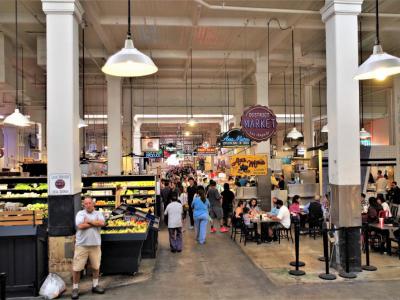
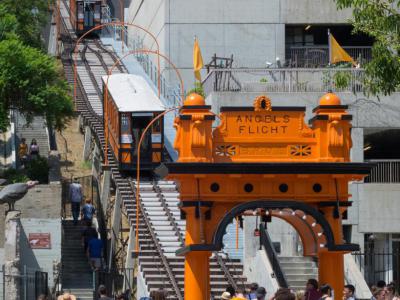
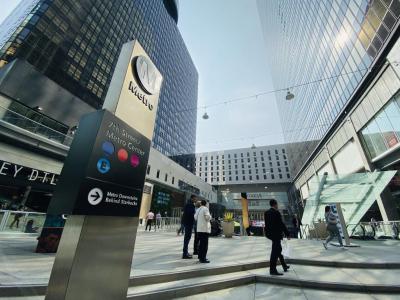
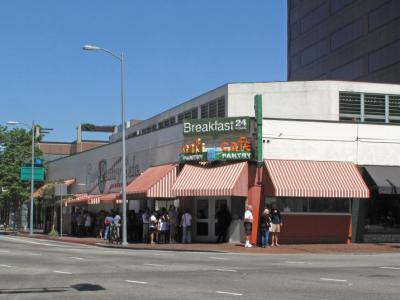





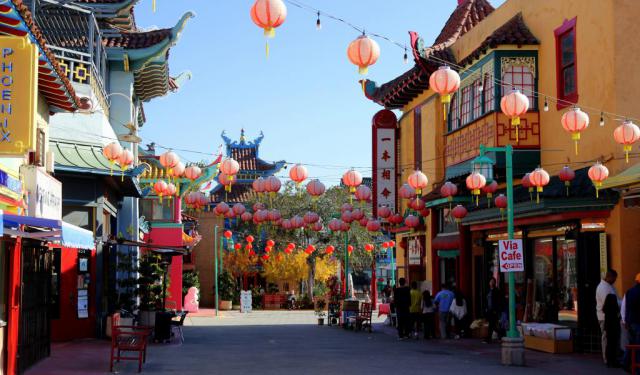


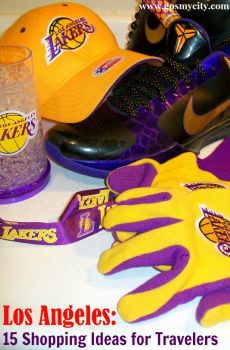
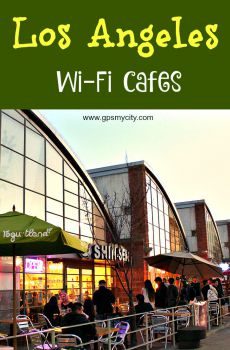
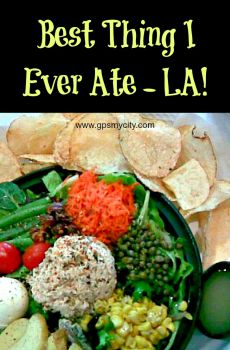.jpg)